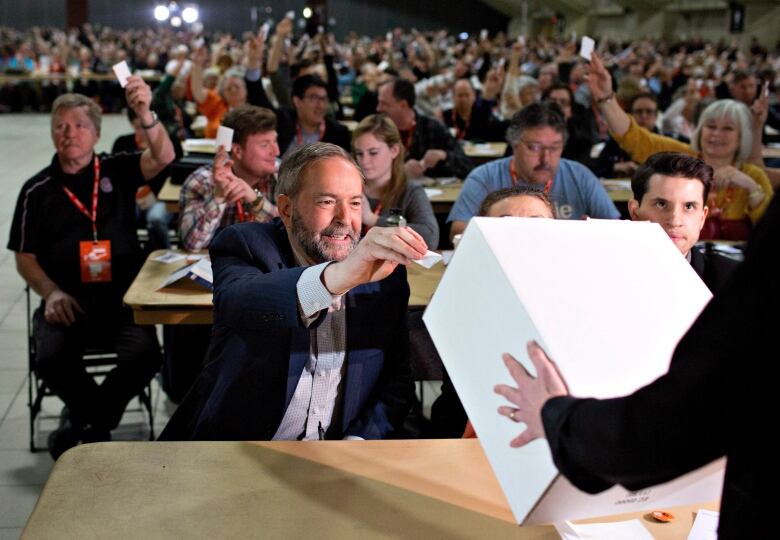Keeping Tom Mulcair may have been safer bet for NDP, history suggests
Parties that have lost seats but kept their leaders have had more future success

Losing seats from one election to the next can sting for the devotees of a political party. The natural reaction may be to call for a change of leadership, as New Democrats did on Sunday at the NDP'sconvention.
But history suggests that a change in leadership is not necessarily a ticket for future success in fact, holding on to the leader may be the safer choice.
- Analysis: NDP lost the left to JustinTrudeau before rejecting Tom Mulcair
- Aaron Wherry: NDP brothers and sisters left between a manifesto and a premier
Both the Conservatives and New Democrats suffered a rebuke at the polls last October, and both parties are now searching fornew leaders.
The Conservatives' choice was made for them when Stephen Harper resigned on election night. But New Democrats made the decision for a change at the topthemselves when52 per cent of party delegates at the convention voted to hold a leadership race.
The reasons for doing so may have varied greatly from delegate to delegatesome likely feltthatMulcair was not equipped to lead the party to greater success in 2019, while others may havedisagreedwith the direction in which he might lead the party, whether or not that would bring the NDP future victories.
But for those delegates who voted for a change of leadership in order to have a better showing in the next federal election, past experience argues against their decision.
A look at past electoral results for major parties that have lost seats from one election to the next at the federal level as well as in provincial electionsin Ontario and Quebec since 1867, for a total of over 120 cases reveals that parties that have retained their leaders after a loss have had better performances in the subsequent election than parties that have undergone a change of leadership.
Unsurprisingly, parties are more likely to change leaders after suffering a loss in seats. This has happened 55 per cent of the time federally and in Ontario and Quebec, while parties that have gained seats have retained their leaders 71 per cent of the time.
In that sense, the NDP's decision was not an unusual one,though that decisionis usually made by the leader him or herself, rather than by party members. But that doesn't necessarily make it a good one.
Love the one you're with
Of the parties that lost seats but stuck with their party leader, 70 per cent of them experienced a gain in seats in the next election with that leader.
Of the parties that lost seats but experienced a change of leadership, 62 per cent had growth in the subsequent election with a new leader.
The good news for the New Democrats is that history suggests they have a two-to-one shot of winning more seats in 2019, as parties have more often than not rebounded after a loss regardless of their leadership situation. Indeed, the NDP has never experienced a drop in seats or vote share in two consecutive elections.

But even if the odds are in favour of the next leader of the NDP doing better than Mulcair did, the party's membership may have had reason to expect more gains under a second Mulcair bid, at least based on the historical precedent.
Parties that have experienced a change of leadership after losing seats have, on average, had their seat totals increased by about 46 per cent in the next election.
But parties that have given their leaders a shot at redemption have, on average, seen their seat total increase by an average of 61 per cent.
In other words, the average rate of growth after losing seats in the next election with the same leader would boost the NDP's current crop of 44 seats to 71, compared to an average increase to64 under a new leader.
In both cases, though, theseats would not make up for the loss of 59 seats the party suffered between the 2011 and 2015 federal election, dropping them from 103.
NDP precedent mixed
There are only limitedexamples to look towithin the federal NDP. The party has lost seats six times, one of which being the last election. In twoof those cases, the leader stayed in place. In the three remainingcases, the leader was replaced. In all cases, the party won more seats in the next election and on average experienced more gains under new NDP leaders than on returning ones after dropping seats.
But there are some less positive examples at the provincial level for the NDP.
In 1975, Stephen Lewis led the Ontario New Democratsto Official Opposition status, dropped back to third party status in 1977, and then suffered more seat losses under new leader MichaelCassidyin 1981.
Bob Rae later led the party intogovernment in 1990 before suffering a stinging defeat in 1995. The reins were then passed on to Howard Hampton, who lost more seats over the next two elections.
The fate of the next leader of the federal New Democrats, of course, will depend on much more than the historical precedent. Nevertheless, thatprecedent suggests Mulcair was more likely tohave done better than whoever his replacement will be if he had been given one more kick atthe can.
- The Pollcast: Subscribe to ric Grenier's podcast
- Manitoba Poll Tracker: Check out the election's latest numbers













_(720p).jpg)


 OFFICIAL HD MUSIC VIDEO.jpg)
.jpg)



























































































